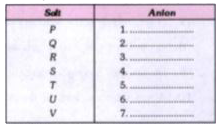On exposure to air, sodium hydroxide becomes liquid and after sometime it changes to white power. Explain.
Sodium hydroxide continuously absorbs moisture and CO2 present in the air thus formaing sodium carbonate solution. A stage reaches when the solution becomes saturated and crystals are formed. These crystals, with the passage of time, lose water of crystallisation (efforescence) and crumble to white power.
Topper's Solved these Questions
- S-BLOCK GROUP 1 - ALKALI METALSBOOK - CENGAGE CHEMISTRY ENGLISHCHAPTER - S-BLOCK GROUP 1 - ALKALI METALSEXERCISE - Ex 4.1 (True/False)
1 Videos
- S-BLOCK GROUP 1 - ALKALI METALSBOOK - CENGAGE CHEMISTRY ENGLISHCHAPTER - S-BLOCK GROUP 1 - ALKALI METALSEXERCISE - Ex 4.1 (Objective)
17 Videos
- S-BLOCK GROUP 1 - ALKALI METALSBOOK - CENGAGE CHEMISTRY ENGLISHCHAPTER - S-BLOCK GROUP 1 - ALKALI METALSEXERCISE - Solved Examples
11 Videos
- REDOX REACTIONSBOOK - CENGAGE CHEMISTRY ENGLISHCHAPTER - REDOX REACTIONSEXERCISE - Archives (Integers)
1 Videos
- S-BLOCK GROUP 2 - ALKALINE EARTH METALSBOOK - CENGAGE CHEMISTRY ENGLISHCHAPTER - S-BLOCK GROUP 2 - ALKALINE EARTH METALSEXERCISE - Ex 5.1 Objective
2 Videos
Similar Questions
On prolonged exposure to air, sodium finally change to :
View SolutionHow does a liquid change into its gaseous state? Explain.
View SolutionThe salt which in solution gives a pale green precipitate with sodium hydroxide solution and a white precipitate with barium chloride solution is
View SolutionIdentify the cation in each of the following case
Sodium hydroxide solution when added to solution C gives bluish white precipitate which is insoluble in excess.
View SolutionSalts P, Q,R,S,T,U and V undergo reactions (i) to (vii) respectively. Identify the cation present in these salts on the basis of these reactions. Tabulate your answer in the formate given below.
(i) When the salt Pis heated with sodium hydroxide solution a vigorous reaction takes place and a colourless gas is evolved with a pungent and suffocating smell that brings tears in our eyes. The evolved gas gives dense white fumes with a moist glass rod depped with hydrochloric acid.
(ii) Addition of sodium hydroxide solution to a solution of salt Q gives a thick white precipitae which is soluble in excess of sodium hydroxide solution to form a clear solution.
(iii) Addition of ammonium hydroxide solution to a solution of salt R gives a dark blue precipitate which is soluble is excess of ammonium hydroxide solution to form an intense deep blue solution.
(iv) Addition of ammonium hydroxide solution to a solution of 5 gives a dirty green [bottle green] precipitate which is insoluble even in the excess of ammonium hydroxide solution.
(v) Addition of ammonium hydroxide solution to a solution of T gives a reddish brown (rust precipitate] precipitate which is insoluble even in the excess of ammonium hydroxide solution.
(vi) Addition of ammonium hydroxide solution to a solution of V gives a geletaneous white precipitate which is soluble in excess of ammonium hydroxide solution to form a clear solution.
(vii) Addition of ammonium hydroxide solution to a solution of V gives no precipitate but it gives a chalky white precipitate with sodium hydroxide solution which is insoluble even in the excess of sodium hydroxide solution.

View SolutionWhite phosphorous is heated with sodium hydroxide the products formed are :
View SolutionAn aqueous solution of sodium hydroxide reacts with white phosphorous to form phosphine and :
View SolutionA white solid P, on strong heating, decomposes to give reddish brown gas R and a residue Q. The residue R is yellow when hot and white when cold. The solution of white solid P in water gives white precipitate S, with concentrated sodium hydroxide. The white precipitate S dissolves in excess of sodium hydroxide solution to form colourless solution.
Another sample of the solid P in water is mixed with ferrous sulphate solution and then to this solution are added a few drops of conc. sulphuric acid. A brown ring is formed at the junction of liquids. Answer the following questions:
Name the salt formed when S dissolves in excess of sodium hydroxide.
View SolutionWhen Cl2 gas reacts with hot and concentrated sodium hydroxide solution, the oxidation number of chlorine changes from
View SolutionX on treatment with sodium hydroxide followed by the addition of silver nitrate give white precipitate at room temperature which are soluble in NH4OH. X can be :
View Solution
